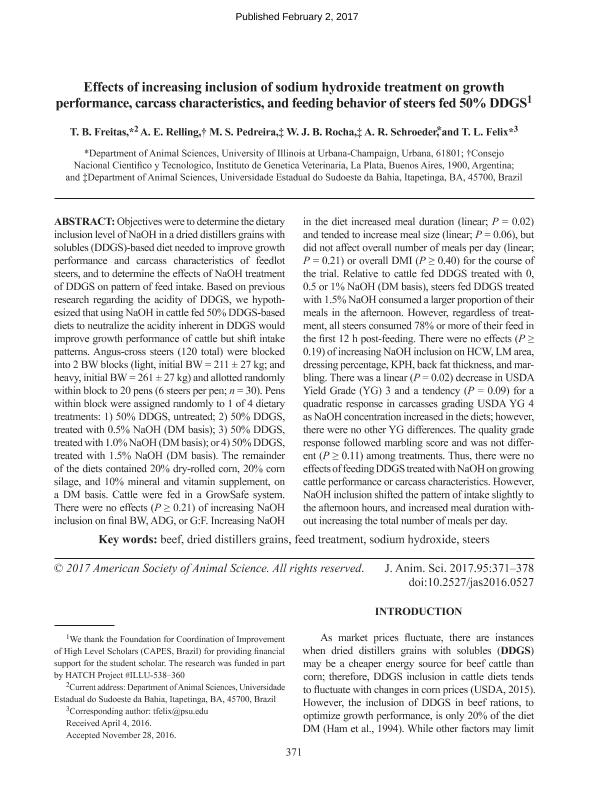Mostrar el registro sencillo del ítem
dc.contributor.author
Freitas, T. B.
dc.contributor.author
Relling, Alejandro Enrique

dc.contributor.author
Pedreira, M. S.
dc.contributor.author
Rocha, W. J. B.
dc.contributor.author
Schroeder, A. R.
dc.contributor.author
Felix, T. L.
dc.date.available
2018-06-12T14:15:49Z
dc.date.issued
2017-01
dc.identifier.citation
Freitas, T. B.; Relling, Alejandro Enrique; Pedreira, M. S.; Rocha, W. J. B.; Schroeder, A. R.; et al.; Effects of increasing inclusion of sodium hydroxide treatment on growth performance, carcass characteristics, and feeding behavior of steers fed 50% DDGS; American Society of Animal Science; Journal of Animal Science; 95; 1; 1-2017; 371-378
dc.identifier.issn
1525-3163
dc.identifier.uri
http://hdl.handle.net/11336/48247
dc.description.abstract
Objectives were to determine the dietary inclusion level of NaOH in a dried distillers grains with solubles (DDGS)-based diet needed to improve growth performance and carcass characteristics of feedlot steers, and to determine the effects of NaOH treatment of DDGS on pattern of feed intake. Based on previous research regarding the acidity of DDGS, we hypothesized that using NaOH in cattle fed 50% DDGS-based diets to neutralize the acidity inherent in DDGS would improve growth performance of cattle but shift intake patterns. Angus-cross steers (120 total) were blocked into 2 BW blocks (light, initial BW = 211 ± 27 kg; and heavy, initial BW = 261 ± 27 kg) and allotted randomly within block to 20 pens (6 steers per pen; n = 30). Pens within block were assigned randomly to 1 of 4 dietary treatments: 1) 50% DDGS, untreated; 2) 50% DDGS, treated with 0.5% NaOH (DM basis); 3) 50% DDGS, treated with 1.0% NaOH (DM basis); or 4) 50% DDGS, treated with 1.5% NaOH (DM basis). The remainder of the diets contained 20% dry-rolled corn, 20% corn silage, and 10% mineral and vitamin supplement, on a DM basis. Cattle were fed in a GrowSafe system. There were no effects (P ≥ 0.21) of increasing NaOH inclusion on final BW, ADG, or G:F. Increasing NaOH in the diet increased meal duration (linear; P = 0.02) and tended to increase meal size (linear; P = 0.06), but did not affect overall number of meals per day (linear; P = 0.21) or overall DMI (P ≥ 0.40) for the course of the trial. Relative to cattle fed DDGS treated with 0, 0.5 or 1% NaOH (DM basis), steers fed DDGS treated with 1.5% NaOH consumed a larger proportion of their meals in the afternoon. However, regardless of treatment, all steers consumed 78% or more of their feed in the first 12 h post-feeding. There were no effects (P ≥ 0.19) of increasing NaOH inclusion on HCW, LM area, dressing percentage, KPH, back fat thickness, and marbling. There was a linear (P = 0.02) decrease in USDA Yield Grade (YG) 3 and a tendency (P = 0.09) for a quadratic response in carcasses grading USDA YG 4 as NaOH concentration increased in the diets; however, there were no other YG differences. The quality grade response followed marbling score and was not different (P ≥ 0.11) among treatments. Thus, there were no effects of feeding DDGS treated with NaOH on growing cattle performance or carcass characteristics. However, NaOH inclusion shifted the pattern of intake slightly to the afternoon hours, and increased meal duration without increasing the total number of meals per day.
dc.format
application/pdf
dc.language.iso
eng
dc.publisher
American Society of Animal Science

dc.rights
info:eu-repo/semantics/openAccess
dc.rights.uri
https://creativecommons.org/licenses/by-nc-sa/2.5/ar/
dc.subject
Beef
dc.subject
Dried Distillers Grains
dc.subject
Feed Treatment
dc.subject
Sodium Hydroxide
dc.subject
Steers
dc.subject.classification
Otras Producción Animal y Lechería

dc.subject.classification
Producción Animal y Lechería

dc.subject.classification
CIENCIAS AGRÍCOLAS

dc.title
Effects of increasing inclusion of sodium hydroxide treatment on growth performance, carcass characteristics, and feeding behavior of steers fed 50% DDGS
dc.type
info:eu-repo/semantics/article
dc.type
info:ar-repo/semantics/artículo
dc.type
info:eu-repo/semantics/publishedVersion
dc.date.updated
2018-06-11T14:27:57Z
dc.journal.volume
95
dc.journal.number
1
dc.journal.pagination
371-378
dc.journal.pais
Estados Unidos

dc.journal.ciudad
Champaign
dc.description.fil
Fil: Freitas, T. B.. University of Illinois at Urbana; Estados Unidos
dc.description.fil
Fil: Relling, Alejandro Enrique. Consejo Nacional de Investigaciones Científicas y Técnicas. Centro Científico Tecnológico CONICET- La Plata. Instituto de Genética Veterinaria "Ing. Fernando Noel Dulout". Universidad Nacional de La Plata. Facultad de Ciencias Veterinarias. Instituto de Genética Veterinaria; Argentina
dc.description.fil
Fil: Pedreira, M. S.. Universidade Estadual do Sudoeste da Bahia; Brasil
dc.description.fil
Fil: Rocha, W. J. B.. Universidade Estadual do Sudoeste da Bahia; Brasil
dc.description.fil
Fil: Schroeder, A. R.. University of Illinois at Urbana; Estados Unidos
dc.description.fil
Fil: Felix, T. L.. University of Illinois at Urbana; Estados Unidos
dc.journal.title
Journal of Animal Science

dc.relation.alternativeid
info:eu-repo/semantics/altIdentifier/doi/https://dx.doi.org/10.2527/jas2016.0527
dc.relation.alternativeid
info:eu-repo/semantics/altIdentifier/url/https://www.animalsciencepublications.org/publications/jas/abstracts/95/1/371
Archivos asociados
